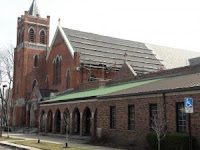The congregation pooled their resources — money, building supplies, skilled labor — to build a church and rectory on the southeast corner of 4th and Elm Streets. A brick church was built at a cost of $8,000 and included a tall steeple and an attached rectory.
Construction was completed the following year and Fr. Leonard Unterreiner arrived as the first pastor. St. Joseph Church was dedicated on November 5, 1871. For fifteen years, 1873-1888, one priest staffed both St. Joseph and nearby St. Patrick. For several years during the 1890s, the parish was served by several Capuchin priests. Fr. Jerome Hieronymous, a Capuchin, raised the funds to build a school which was then dedicated in the early 1890s.
The school was built on the south side of Elm Street. The Sisters of St. Agnes of Ford du Lac, WI were the first teachers, followed a few years later by the Adrian Dominican Sisters, who remained with the school for many years. Originally, classes were taught in both English and German.
The first rectory burned down in 1881 and was replaced by another rectory, further away from the church. When the church first opened, it heated by only one potbelly stove. The church relied and natural light and candlelight before it was wired for electricity in 1905. In 1916, lightning caused a fire in the original spire of the church, which ruined it and resulted in considerable water damage to the interior of the church. A much smaller square cupola replaced the spire. Another rectory, measuring 6,500 square feet, was built in 1918 at a cost of $15,000.
Construction of a larger school began in 1939, less than a block south of the church. Classes were soon held in the unfinished school but World War II delayed its completion in 1949.
By the early 1950s, St. Joseph Church needed many repairs and the congregation had outgrown it. Fr. Albert George ordered it torn down in 1951 and Masses were held in the gymnasium of the school. The arrival of Fr. Walter Hennes in 1954 prompted a capital campaign to construct a new church. The first step was the purchase of the Arbeiter Hall, a German blue-collar workers’ assembly hall. This is the land on which this church now stands across the street from the first church. Ground was broken on the new edifice in 1958 and they new church was dedicated in May, 1960.
In 1961, Fr. Joseph Bohr became pastor and led the parish through the years of Vatican II until he was replaced by Msgr. John Weier in 1978. Cardinal Szoka assigned Pallottine Fathers to St. Joseph Parish in 1990, under the direction of Fr. Gerry Frawley. The Pallottines had been in Wyandotte since the 1950s but ministered at other parishes. Fr. Michael Cremin, SAC, was assigned as pastor in 2004 and remains there today.
St. Joseph School merged with St. Patrick School and St. Elizabeth School to form Wyandotte Catholic Consolidated Elementary School before it closed in 2011. The school building is still used for religious education classes.
In 2010, St. Joseph clustered with St. Patrick (est. 1857) and St. Elizabeth (est. 1924). The final Mass at St. Elizabeth was on June 30, 2012. At the time of the closure, there were 75-100 families at St. Elizabeth.
 |
| Bishop Francis Reiss celebrated the closing Mass at St. Elizabeth. Fr. Cremin stood next to him, at his right side. - Source |
The two remaining parishes merged in 2013 to form St. Vincent Pallotti Parish, patron of the Irish Pallotine priests who minister to the parish. A statue of the patron stands in a niche near the back of the church.
The old rectory was torn down in 2015 because of high maintenance and health concerns. Below are street view images from 2013 and 2017, respectively.
St. Alphonsus Liguori on the facade of a side entrance. A statue of St. Elizabeth of Hungary was transferred from the shuttered St. Elizabeth Church and currently stands inside a niche.
Two sets of tall, narrow windows flank the tabernacle. St. Michael the Archangel is depicted on the right side. Madonna and Child are shown on the top left while a family is depicted in the bottom left.
Symbols of the sacraments surround the crucifix and tabernacle.
Side altars to the Blessed Virgin Mary and St. Joseph, respectively.
The Sacred Heart of Jesus and St. Anthony of Padua on the back wall.
The front facade shows four depictions of St. Joseph. The largest and highest shows St. Joseph holding two doves (the Presentation at the temple) and his flowering staff. The other three images show, from left, the Flight into Egypt, the Nativity of Our Lord, and Christ Child at work with St. Joseph.
More about the parish: STVPP.org
More photos by AOD Film Services: St. Elizabeth + St. Joseph
Articles by The News Herald: three-parish cluster
More about the Irish Pallottines: IrishPallottines.org
Articles from The Michigan Catholic: October 2011 + March 2016






































































